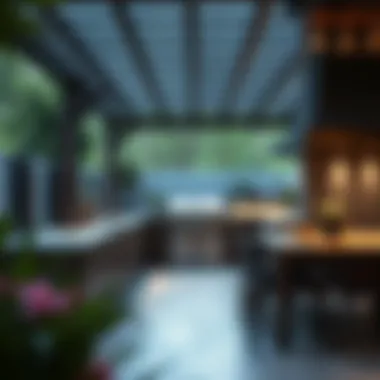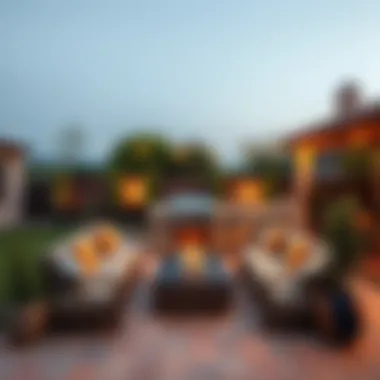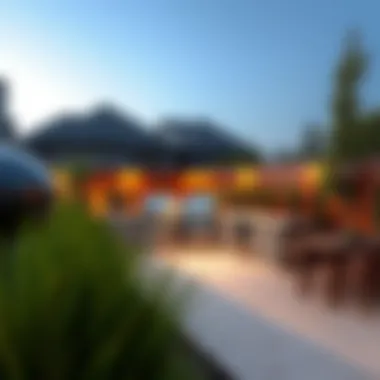Designing Outdoor BBQ Kitchens: Essential Tips and Ideas


Intro
Creating an outdoor BBQ kitchen is more than just setting up a grill and tossing some burgers on the fire. It reflects a lifestyle—one that values culinary creativity and social engagement in a setting that combines the comfort of home with the beauty of nature. In today’s fast-paced world, outdoor cooking has become a significant trend, offering a space where family and friends can gather to enjoy good food and good company.
This guide aims to uncover the essential components and intricate details that go into designing an outdoor BBQ kitchen. From the functional aspects like layout and materials to aesthetic considerations that make this space pop, we will explore every facet necessary to transform your backyard into an inviting culinary oasis. Whether you're a homeowner looking for inspiration or a designer searching for fresh ideas, this guide will provide practical solutions and current trends that can elevate any outdoor cooking scheme.
Success in designing your kitchen means considering not only what you want but also how to make those desires a reality. It’s about striking a balance between practicality and style, ensuring that each element contributes to an atmosphere conducive to both cooking and relaxing. Let’s dive into the exciting realm of outdoor BBQ kitchens, and discover how to create a seamless, stunning, and functional space that you'll love for years to come.
Preface to Outdoor BBQ Kitchens
Designing an outdoor BBQ kitchen is much more than just positioning a grill in the backyard. It encapsulates a lifestyle that merges cooking, entertaining, and enjoying nature. Over the last few years, the popularity of outdoor cooking has surged, becoming a staple in many homes. The outdoor BBQ kitchen is now recognized not only as a way to expand one’s culinary space but also as a hub for social interaction.
The Rise in Outdoor Cooking
The trend toward outdoor cooking can be traced back to a growing appreciation for grilling and the experience of dining al fresco. No longer considered a mere summer activity, outdoor cooking has become a year-round endeavor. According to surveys, many homeowners now prioritize outdoor kitchens when investing in their properties.
Moreover, social dynamics have shifted; families and friends gather differently now. A well-designed outdoor BBQ kitchen offers an inviting atmosphere, promoting connection and conversation. Picture a warm summer evening with the aroma of freshly grilled steaks wafting through the air, creating memories that linger long after.
Benefits of an Outdoor BBQ Kitchen
The benefits of an outdoor BBQ kitchen extend far beyond just convenience. Here are a few reasons why investing in one can elevate your home life:
- Enhanced Cooking Space: An outdoor kitchen provides a dedicated space away from the confines of indoor cooking. It allows for more creativity in meal preparation.
- Improved Property Value: As outdoor kitchens gain traction, homes equipped with them often see a boost in market value. Real estate agents frequently highlight such features during showings.
- Encouraged Entertaining: With built-in seating and cooking areas, outdoor kitchens promote a festive environment. You can easily host barbecues, parties, or family gatherings without the hassle of crowding inside.
- Health Benefits: Cooking outdoors often leads to healthier meal choices. Grilling can be a lighter alternative, keeping meals flavorful yet nutritious.
- Customization Opportunities: An outdoor BBQ kitchen can be personalized to fit your taste. You can choose the layout, appliances, and materials to create a space that reflects your style.
"The joy of grilling isn't just about cooking; it's about creating moments with loved ones, under the open sky."
As you embark on the journey to designing your outdoor BBQ kitchen, it's crucial to understand these aspects to make informed decisions that align with your lifestyle and goals.
Key Elements of BBQ Kitchens
Designing an outdoor BBQ kitchen involves careful consideration of multiple factors that can enhance both functionality and aesthetics. The elements selected for your BBQ kitchen are often the backbone of the overall experience. They not only define how efficiently the space will function but also contribute to the atmosphere and visual appeal of your outdoor area. Realizing this potential starts with understanding the essential components that make a BBQ kitchen truly effective.
Layout Considerations
Work Triangle Concept
The Work Triangle Concept is a foundational principle in kitchen design that emphasizes the relationship between the three main areas of any cooking space: the cooktop, the refrigerator, and the sink. This principle counts on the measurement of distances between these areas and aims to create an efficient workflow that reduces unnecessary steps. By enabling the cook to pivot easily between these stations, the kitchen becomes more user-friendly.
This layout is a favorite among designers due to its focus on ergonomics. The unique aspect of the work triangle is its adaptability; it can be tailored to fit various sizes and shapes of outdoor kitchens, from compact configurations to expansive estates. However, it’s important to watch for its drawbacks as well—if the distances become too great or if the flow is disrupted by obstacles, it could lead to a frustrating cooking experience.
Zoning for Cooking and Dining
Zoning is another critical design strategy that involves dividing the outdoor kitchen into distinct areas for cooking, dining, and relaxation. This organization allows for a more structured experience, making it easier for guests to engage in social activities without crowding the cook. By creating zones, homeowners can tailor each section of the kitchen for specific activities—keeping the barbecue area separate from seating or dining spaces.
The key characteristic here is the ample space created around each zone. One zone can facilitate the grilling process while another may serve cocktails or appetizers. This division helps minimize disturbances, allowing both cooks and diners to enjoy their activities without tripping over one another. A drawback might be the need for additional space; if the areas are not well-planned, they could make the entire setup feel cramped.
Essential Appliances
Grills: Types and Features
When it comes to outdoor BBQ kitchens, grills are arguably the star of the show. Various types of grills—like charcoal, gas, and electric—offer unique features that can greatly influence the cooking experience. Gas grills are sought after for their convenience and quicker preheat times, while charcoal grills bring a smoky flavor that many enthusiasts swear by. Each type has its devoted following, affecting flavors, ease of use, and maintenance needs.
A major consideration when choosing a grill is the size and configuration, which should match your cooking style and the needs of your gatherings. Beyond just grilling capabilities, many modern grills offer added features such as rotisserie attachments, side burners, or smoker boxes, enhancing their versatility. Nonetheless, choosing a grill that fits your style is vital; a massive grill may overwhelm a small space, while a compact one could hamper the experience during larger gatherings.
Refrigeration and Storage Solutions
Outdoor kitchens should also incorporate smart Refrigeration and Storage Solutions to keep essentials at hand while preparing meals. Refrigerators designed for outdoor use are particularly resistant to weather elements, offering students of the culinary arts easy access to beverages and ingredients without frequent trips indoors. These refrigerators come in various sizes and can be seamlessly integrated into cabinetry for a polished look.
Unique features of outdoor fridges include adjustable shelving, energy efficiency, and sometimes glass doors that provide visibility without requiring you to open the fridge. A disadvantage, however, is the cost; high-quality outdoor refrigeration can represent a significant investment and requires careful planning to ensure proper connection and cooling performance.


Counter and Preparation Space
Material Options
Material Options for countertops in outdoor BBQ kitchens range from classic granite to stainless steel, and each material carries distinct advantages and disadvantages. Granite countertops, for instance, are lauded for their durability and resistance to heat. They can withstand the rigors of an outdoor environment while lending an upscale appearance to the cooking area.
On the other hand, stainless steel is favored for its modern aesthetics and easy maintenance. However, it may not provide the same level of heat resistance, necessitating caution during peak grilling temperatures. Vishan a unique feature here is the non-porous nature of stainless steel, which minimizes bacterial growth, thus ensuring hygiene in food preparation.
Surface Durability
Considering Surface Durability is paramount for any outdoor kitchen. The surface must endure not only heat but also the elements. Materials like quartz or concrete stand up to the test, providing durable work surfaces that require minimal upkeep. Countertops with high durability help prevent scratches, chips, and stains, which could deter from the kitchen's aesthetic appeal over time.
The challenging part of selecting durable surfaces includes balancing appearance and functionality. For instance, while marble may look stunning, it’s notoriously susceptible to scratches and cannot handle acidic spills well. Each material brings its own pros and cons, and thinking through usage can help land on a wise choice.
Choosing Materials for an Outdoor BBQ Kitchen
Selecting the right materials for an outdoor barbecue kitchen is a decision that extends beyond mere aesthetics; it's a fundamental aspect that intertwines durability, functionality, and style. A well-thought-out selection process can bolster the longevity of the space and enhance the overall cooking experience. Homeowners are often faced with the challenge of finding materials that can withstand the rigors of outdoor living while also complementing the surrounding landscape and architecture. Therefore, knowing the various options available and their respective strengths and weaknesses is crucial for anyone looking to create a backyard culinary sanctuary.
Weather-Resistant Materials
Stone vs. Concrete
When it comes to outdoor kitchen surfaces, stone and concrete frequently top the list of materials to consider. Both materials offer unique advantages and a few limitations.
Stone has an innate beauty about it, evoking a sense of timelessness and natural elegance. It is often chosen for its durability and ability to withstand harsh weather conditions. However, it can be pricey and somewhat heavy, which might complicate installation. On the flip side, concrete is usually more budget-friendly and can be molded into various shapes and sizes, opening up design possibilities. While it might not have the same warmth as a natural stone, the aesthetic appeal can be enhanced with stains and sealants, giving it a customized look.
In summary, both stone and concrete remain popular choices for outdoor kitchens, largely due to their resilience and adaptability. Below are some key characteristics for comparison:
- Stone: Durable, beautiful, heavier, usually more expensive.
- Concrete: Cost-effective, versatile, lighter but can crack if improperly treated.
Stainless Steel Durability
Another critical player in material choice is stainless steel. Its go-to reputation in outdoor kitchen environments stems from its remarkable durability and resistance to rust, corrosion, and heat. With outdoor appliances like grills and refrigerators often exposed to the elements, stainless steel provides peace of mind that they will hold up season after season.
One major perk of stainless steel is that it’s easy to clean, which is vital when cooking with various meats and sauces, as spills are inevitable. However, one must take care when choosing the finish; some can show fingerprints or smudges. A brushed finish can minimize this problem and maintain that sharp, modern appearance.
In a nutshell, stainless steel harmonizes form with function by offering:
- Key Characteristics: Durable, easy maintenance, rust-resistant.
- Unique Features: Modern look, typically more expensive than painted metal finishes, and a seamless aesthetic.
Aesthetic Considerations
Color Schemes
Color plays a pivotal role in shaping the overall vibe of an outdoor BBQ kitchen. Choosing the right color scheme can elevate the space and create a harmonious connection with the surrounding area. Neutral colors provide a classic backdrop that won’t age quickly and can easily blend with different landscaping styles. Meanwhile, bold, bright colors can add a splash of personality.
Incorporating colors that mimic natural surroundings enhances the connection to nature, which is often a primary reason people design outdoor areas. Additionally, color schemes can influence the perceived size of the space. Lighter shades tend to open up smaller areas, while deeper tones can offer coziness.
Integration with Landscape Design
An outdoor BBQ kitchen should seamlessly integrate with landscape design instead of standing out like a sore thumb. Elements like natural stone pathways or rustic wood accents can enhance the overall aesthetic. By considering the natural contours of your yard and the existing flora, a well-placed outdoor kitchen can form a cohesive dialogue with its surroundings.
Key aspects of integration include:
- Matching materials like using the same stone for countertops as for garden paths.
- Aligning colors with plants and flowers.
- Utilizing appropriate lighting that enhances the nighttime beauty of both the kitchen and the landscape.
Design Styles for Outdoor BBQ Kitchens
Design styles for outdoor BBQ kitchens play a vital role in both functionality and aesthetic appeal. They can reflect a homeowner's personality, enhance the property’s value, and create an inviting atmosphere for gatherings. Choosing the right design style will also influence the materials, appliances, and layout of the kitchen. Each style communicates a different vibe, offering unique opportunities for creativity and enjoyment.


Modern Minimalist
Modern minimalist design focuses on simplicity and clean lines. This approach often utilizes muted color palettes, including whites, grays, and blacks, establishing a tranquil setting. Materials like concrete and stainless steel dominate this style, promoting durability alongside elegance.
Using less clutter and more space is key here. The appliances, such as sleek gas grills and integrated refrigerators, should seamlessly blend into cabinetry, and even be hidden behind doors. Furniture choices lean towards the simple, with few embellishments.
Incorporating a few plants or greenery can add life to a minimalistic environment without overwhelming it. Moreover, the open layout often symbolizes an invitation to the outdoors, allowing for a pleasant cooking experience without distractions.
"Simplicity is the ultimate sophistication." — Leonardo da Vinci
Rustic Charm
Rustic charm emphasizes warmth and a cozy, homey atmosphere. This style draws inspiration from nature and traditional designs, often characterized by the use of natural materials such as wood, stone, and brick. The color palette generally consists of earth tones, creating a grounded feel.
In a rustic BBQ kitchen, one can include oversized wooden tables, stone countertops, and classic charcoal grills. Copper or cast-iron accessories complement the rustic vibe nicely. Furthermore, simple decorative accents like hanging light fixtures made from wrought iron can add character.
One of the main advantages of this style is its ability to foster a welcoming environment, encouraging conversations and connections. The juxtaposition of rugged materials and softness helps create a space that feels like an extension of nature and home.
Mediterranean Inspired
Mediterranean-inspired designs bring an exotic flair to outdoor BBQ kitchens. Characterized by bright colors, intricate tiles, and curved lines, this style evokes a sense of sunshine and warmth. Shades like terracotta, turquoise, and sunny yellows create a vibrant atmosphere.
Key features of this design often include arched doorways, tiled backsplashes, and bold decorative elements. Grilling areas might utilize brick ovens or charcoal grills, creating an authentic outdoor cooking experience. The furniture typically features wrought iron or vintage-style seating arrangements, enhancing the casual yet elegant vibe.
One distinct advantage of this style is its flexibility in incorporating various elements from different cultures, which allows for customization. It reflects the joy of outdoor cooking, pushing homeowners to embrace culinary delights while enjoying the fresh air.
In summary, choosing the right design for an outdoor BBQ kitchen hinges on personal taste, functionality, and the desired atmosphere. Whether opting for modern minimalist, rustic charm, or Mediterranean inspired, each style can uniquely cater to the needs of homeowners while enhancing the overall aesthetic of outdoor living spaces.
Incorporating Seating and Dining Areas
Creating an outdoor BBQ kitchen isn’t just about the grilling setup. The seating and dining areas play a crucial role in transforming your culinary space into a gathering spot. It enhances the overall experience, encouraging people to linger and enjoy their meals al fresco. As much as you want to whip up delicious grilled treats, having a comfortable and inviting area to enjoy them is just as important. The harmony of cooking and dining areas can make the difference between a simple cookout and an unforgettable evening under the stars.
Outdoor Dining Solutions
When planning your outdoor space, it’s vital to consider how your dining area will flow with the cooking space. You might want to look at various solutions available for outdoor dining that suit different occasions. Options can range from a rustic wooden table and benches for casual family meals, to elegant wrought iron set-ups for more formal dinner parties. Here are several outdoor dining solutions to ponder:
- Picnic Tables: Great for casual gatherings, they invite a serene and relaxed atmosphere.
- Dining Sets: A classic choice, offering comfort with plush cushions and often built from durable materials.
- Bar Carts: Perfect for a quick meal; they bring a sense of ease and mobility to your outdoor dining experience.
Think about the number of people you typically entertain. If your space allows it, choosing a table that can seat six to eight will accommodate family gatherings and friends' get-togethers without feeling cramped.
Comfort and Functionality
Seating Layout
When it comes to seating layout, it’s all about maximizing comfort while allowing for smooth interactions. A well-thought-out seating arrangement means easy access to food and drinks and a space where guests can engage in conversation without feeling forced together. For instance, using a U-shaped configuration can create a cozy setting that encourages communication, while also giving people space to enjoy their plates without elbowing each other.
One characteristic of a favorable seating layout is flexibility. Opting for movable seating can let you adapt the space to seasonal gatherings or spontaneous mingling moments. However, arranging the seating too close can make it feel cramped, compromising comfort—a key element in outdoor enjoyment.
Materials for Outdoor Furniture
Next up, the materials for outdoor furniture. It’s a big topic, as the right choice can greatly impact durability, maintenance, and aesthetic appeal. Choosing materials like teak wood or powder-coated aluminum provides a good mix of elegance and strength. Durable materials withstand the elements, making them a popular choice in outdoor spaces.
A standout feature of some materials is their resistance to fading. For instance, high-density polyethylene can withstand sun exposure and harsh weather while keeping their colors vibrant. This means less worry about replacement costs and more time spent enjoying your outdoor kitchen. However, some materials might require regular upkeep to maintain their appearance or withstand wear and tear, which is why researching ahead might save headaches later.
Overall, incorporating soothing seating options and dining areas enhances your outdoor BBQ kitchen's capacity as a harmonious gathering place. It creates a visual appeal that draws guests in and keeps them comfortable as they savor each grilled delight, forging lasting memories in your splendid outdoor oasis.
Remember, the joy of outdoor cooking is not just in the act itself but in sharing the meal with those you care about.
Lighting and Ambiance


Lighting and ambiance play a crucial role in the overall aesthetic and functionality of outdoor BBQ kitchens. The right lighting can transform a simple outdoor space into an inviting and visually appealing area, where cooking and dining become pleasurable experiences. Not only does lighting enhance the beauty of the kitchen, but it also contributes significantly to safety and usability during nighttime cooking and entertaining. Thus, homeowners and designers alike should consider various lighting options to create a warm, welcoming atmosphere that encourages gatherings and culinary adventures.
Types of Outdoor Lighting
Task Lighting
Task lighting serves a specific function: providing illumination for cooking activities. It mainly includes focused lights that highlight prep areas, grilling stations, and dining tables. The primary characteristic of task lighting is its ability to offer intense, directed light, ensuring you can see what you're doing, even under the stars.
One reason why many consider task lighting essential is its contribution to safety. When grilling, for instance, proper lighting helps avoid accidents, making it easier to see flames and food. Moreover, task lighting can come in various forms—like pendant lights above the grill or spotlights directed at preparation surfaces. Such versatility makes it a popular choice for outdoor cooking areas.
However, it’s important to recognize that task lighting has its downsides too. It can sometimes create harsh shadows if not positioned properly. Therefore, careful planning is vital to maximize its benefits without sacrificing overall ambiance.
Ambient Lighting
Ambient lighting, on the other hand, sets the mood for gatherings and relaxation. Unlike task lighting, which is designed specifically for work, ambient lighting establishes a gentle glow around the cooking area, enveloping it in warmth and inviting comfort. Its soft, diffused nature makes outdoor spaces feel cozy and more accessible.
The key characteristic of ambient lighting is its ability to fill in the gaps where task lighting may fail. For example, outdoor string lights or wall-mounted fixtures can provide a soothing background glow that encourages people to linger. It’s an excellent addition for evening get-togethers or simply enjoying the night sky.
One unique feature of ambient lighting is its capacity for creativity. It allows homeowners to express themselves through decorative choices, like fairy lights or lanterns. However, there are some considerations; too much ambient light can wash out the space, making it lose its charm. A balance between task and ambient lighting can lead to a harmonious blend, avoiding a sterile environment.
Creating a Welcoming Atmosphere
Crafting a welcoming atmosphere in an outdoor BBQ kitchen goes beyond just physical elements—it's about evoking feelings of comfort and joy. Creating such an environment involves integrating thoughtful design choices, effective lighting strategies, and carefully chosen furniture pieces. When these components come together, they lay the foundation for memorable gatherings and experiences.
Using various layers of lighting, be it task, ambient, or accent lighting, creates depth and interest. Privacy hedges or landscaping can further enhance the feeling of seclusion, allowing families and friends to fully embrace their outdoor experience. Whether it's a subtle glow from behind a bush or a warm light shining on gatherings, ambiance becomes key.
Maintenance and Care of Outdoor BBQ Kitchens
Caring for your outdoor BBQ kitchen is not just about keeping it clean; it's about enhancing your investment and ensuring its longevity. As structures situated in the elements, outdoor kitchens face unique challenges, such as weather conditions and dirt accumulation. The maintenance habits you build for your BBQ kitchen will directly affect its functionality and aesthetics, enabling you to enjoy cooking and hosting for years ahead. Ending up with rusted equipment or cracked counters isn’t something any homeowner wishes for, so let’s dive into this crucial aspect of BBQ kitchen design.
Seasonal Maintenance Checklists
Regular maintenance checks are crucial in preserving the function and beauty of your outdoor BBQ kitchen. Implementing a seasonal checklist can help you manage this process effectively. Here are the key items to focus on:
- Spring Cleanup: As the weather warms up, start with a thorough cleaning. Remove debris, check for any winter damage, and deep clean your grill. Use a grill brush and an appropriate cleaner for grease buildup, paying special attention to burners and grates.
- Summer Check: The peak cooking season means heavier use. Inspect all appliances and workstations for any wear and tear. It's time to replace any missing knobs or handles, and also inspect hoses for your gas grill to ensure safety.
- Autumn Prep: Before the first frost creeps in, it’s essential to prepare your BBQ kitchen for winter. Drain any water lines connected to outdoor sinks and cover your grill to protect it from snow and moisture.
- Winter Inspection: Though you might not use it much, perform regular checks to prevent damage from ice. Ensure that the cover remains intact, and remove any snow accumulation to prevent pressure buildup on the structure.
Creating these seasonal reminders allows you to keep things shipshape and spot issues before they escalate into bigger problems.
Cleaning Recommendations for Longevity
A well-maintained and regularly cleaned BBQ kitchen not only extends usability but also enhances its aesthetic appeal. Here are some cleaning practices you should adopt to achieve longevity:
- Use the Right Tools: Invest in durable cleaning tools such as stainless steel brushes, non-scratch scrub sponges, and soft cloths. These will help prevent damage while effectively cleaning surfaces.
- Choose Appropriate Cleaners: Be cautious about chemical cleaners. Always opt for pH-balanced options that won't harm surfaces like stone or stainless steel. A natural solution of vinegar and water can also work wonders.
- Grill Maintenance: Don't forget about the grill. After each use, allow it to cool slightly and scrape off residue with a grill brush. Cleaning the interior and exterior weekly will keep it ready for the next cookout.
- Countertops: Depending on your material, pay attention to specific requirements. For stone surfaces, avoid acidic cleaners and regularly apply a sealant to protect against staining. Wood surfaces should be treated with mineral oil to prevent drying out.
Always remember, prevention is easier than a cure. Taking diligent care of your outdoor BBQ kitchen will set the stage for countless gatherings filled with rich aromas and good times. You’ll be grateful for the effort when the grill is primed and ready to go at a moment's notice.
"An ounce of prevention is worth a pound of cure." – Benjamin Franklin
For more tips on maintaining your outdoor kitchen, you can visit resources like This Old House or Family Handyman.
Epilogue
As we wrap up this journey into crafting the perfect outdoor BBQ kitchen, it's clear that the importance of thoughtful design goes beyond mere aesthetics. A well-planned cooking space is not just about grilling burgers or flipping steaks; it's about creating an experience that brings people together, blending functionality with pleasure. The layout you choose, the materials you select, and the appliances you integrate all play a pivotal role in the utility and enjoyment of your outdoor culinary space.
Key Takeaways
- Functionality First: Prioritizing the layout and flow can tremendously impact your outdoor cooking efficiency. Consider the work triangle and ensure ease of movement between preparation, cooking, and serving areas.
- Material Matters: Choosing durable, weather-resistant materials will safeguard your kitchen from the elements, ensuring longevity and practicality. Stainless steel and natural stone are popular for a reason—they combine beauty with resilience.
- Aesthetic Synergy: Your BBQ kitchen should harmonize with the overall landscape. Choose colors and designs that complement your home and outdoor environment, enhancing the visual appeal.
Future Trends in Outdoor BBQ Kitchens
Outdoor BBQ kitchens are evolving, reflecting changing lifestyles and preferences. Here are some trends to watch for:
- Sustainable Design: Eco-friendly materials and energy-efficient appliances are gaining traction. Homeowners are looking for ways to reduce their carbon footprint while enjoying outdoor cooking.
- Smart Technology: Increasingly, BBQ kitchens are becoming integrated with smart home technology. From temperature controls to smartphone apps that alert when food is ready, technology is making outdoor cooking simpler and more interactive.
- Outdoor Entertainment Integration: Many are merging leisure and cooking, with features like outdoor TVs, sound systems, and lighting creating inviting atmospheres for gatherings.
As you finalize your outdoor BBQ kitchen design, keep these considerations in mind. Tailoring your space to your unique needs and staying ahead of the curve can create a personalized outdoor oasis that enhances both your cooking and social experiences. Cooking outdoors becomes not just a task but a jubilant occasion, bringing conviviality and warmth into every meal shared with family and friends.



